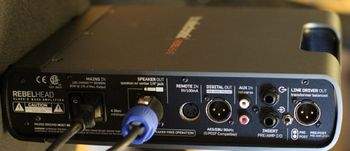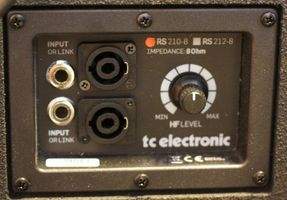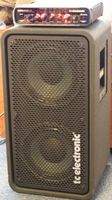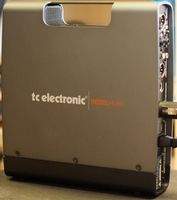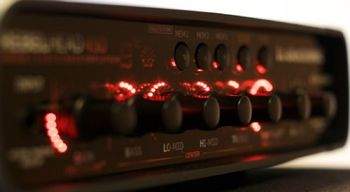Well-known for its studio and guitar digital effects, TC Electronic enters the bass market with the RebelHead450, a 450-watt amplifier head with speaker cabinet.
When a manufacturer like TC Electronic presents a new bass amplifier head, we all have the feeling that we are about to discover something modern, and we are right! As soon as you start opening the amps’ packaging, you’ll notice that you’re not dealing with a “vintage” model. The RebelHead 450 has a very nice design–in the best TC tradition–, LEDs all over the place, a very compact size, and seems very sturdy at first glance. The amp is packed with good ideas: a handle that allows an easier transportation of its 8.8 lbs., the possibility to place it vertically or horizontally, endless rotary knobs with LED rings, a nice PVC front panel with black glossy finish…
The RebelHead makes a very good first impression but let’s see if the inside matches the outfit…
Front Controls
Let’s go back to the Mute and Shift buttons. The first one allows you to mute the amp signal, while the second one gives you access to advanced functions: for example, you can adjust the center frequency for each of the bands of the EQ for a more accurate setting, and you can set the compressor and the tube-preamp simulation. The Shift button deactivates automatically after some time, which is good idea!
Now, let’s take a look at the back of this little rebel…
Rear Connectivity
Now that we’ve explored the RebelHead’s features, let’s listen to it…
Sound
We tested the RebelHead with a Fender Road Worn Jazz Bass, a BeyerDynamic M88 mic, and also through the direct out.
Now let’s listen to the TubeTone function which is supposed to simulate a tube preamp. The goal of the effect is to add to the signal a certain color resembling this type of amps. TubeTone simulates both a preamp stage and a power amp. In practice, it adds a typical sound character to the signal, and whereas the effect stays rather pleasant and subtle with reasonable settings, higher settings produce a rather unpleasant sound through the direct out (because of the very aggressive highs). Nonetheless a good mic placed in front of the speaker gives better results! This kind of sound could also be used as an occasional sound effect.
Below you’ll find some additional sound samples of the RebelHead 450:
* Pick 1
* Pick 2
* Pick 3
* Slap 1
* Slap 2
* Slap 3
* Clean
The main feature to be highlighted about this amp is its very precise and effective EQ. We liked the four parametric bands that allow you to freely shape your sound. We discovered a comprehensive and versatile amp enhanced with an ultra-effective multiband compressor and a really nice TubeTone function. TC Electronic successfully created a modern amp with all the advantages that that entails: high output power, compact size, ergonomic design and competitive pricing. Well done!
Conclusion
|
Classic450 TC Electronic also offers a more affordable version without some of the features of the RebelHead450. With a nearly 20% lower price tag, it also provides 450 watts of output power and the SpectraComp and TubeTone functions, but it has no integrated tuner, no headphone output, no user memories, no AES/EBU digital output, no remote connector (does it really matter?), no aux input and a simple 4-band EQ with fixed frequencies instead of the parametric EQ. Even though it does have the main features, we do miss some of the special functions that make the RebelHead so appealing. It’s up to you (and your needs) to decide if you’re willing to pay the difference. |
Being its first attempt on the bass amp market, TC delivers a masterstroke with an original, modern and comprehensive product. So far so good. The RebelHead is a very powerful tool with a very good multiband compressor and a nice tube simulation section.
The presets and the compact size are very convenient, the compact and rugged speaker cabinet provides high-quality sound… To be honest, it’s very difficult to find drawbacks. Bass players looking for a versatile amp ought to give it a try at their favorite dealer. In the end, choosing a high-class amp is a matter of taste, but we are positive that the RebelHead will easily find its fans.
- Convincing TubeTone
- Very effective SpectraComp
- High-quality sound
- Very good EQ
- Digital output
- Compact size
- Design
- Carrying handle
- Three presets
- Integrated tuner
- Headphone output
- High output power
- FX loop
- Easily linking to other amps
- Aux input
- On/Off switch on the rear panel
- And that’s it!






